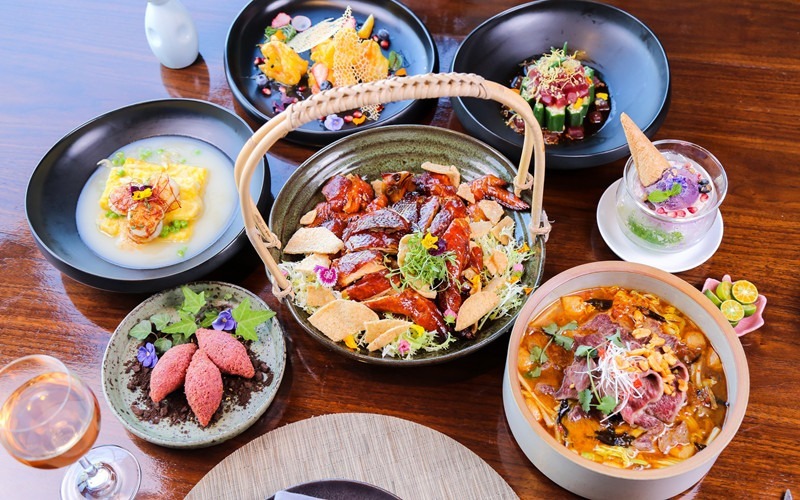
Beijing Food Culture: A Guide to Culinary Delights from Street Food to Michelin Star Restaurants
Beijing, China's historical capital, boasts a rich culinary tapestry woven over centuries. More than just a feast for the senses, Beijing's food culture offers a fascinating glimpse into the city's vibrant past and its evolving present. This comprehensive guide takes you on a delectable journey through the heart of Beijing's food scene, from bustling street food stalls to sophisticated Michelin-starred restaurants.
1. Beijing Cuisine: A Fusion of History and Culture
As the imperial capital for centuries, Beijing's cuisine has been influenced by culinary traditions from across China. The result is a unique blend of flavors and cooking styles that define "Jing Cuisine," characterized by its emphasis on rich aromas, bold flavors, and a harmonious balance between savory and umami tastes.
The abundance of wheat in northern China led to the prominence of noodles, dumplings, and pancakes in Beijing's cuisine. At the same time, the imperial court's influence brought about elaborate cooking techniques and the use of premium ingredients, shaping the city's fine-dining landscape.
2. Must-Try Beijing Street Food Delicacies
No culinary exploration of Beijing is complete without diving into its vibrant street food scene. Here are some must-try delicacies:
| Dish | Description | Where to Find |
|---|---|---|
| Peking Duck (北京烤鸭) | Crispy-skinned duck served with thin pancakes, spring onions, and sweet bean sauce. | Qianmen Street, Guijie (Ghost Street) |
| Zha Jiang Mian (炸酱面) | Thick wheat noodles topped with a savory fermented soybean paste sauce, minced pork, and fresh vegetables. | Huguosi Snacks, Any local restaurant |
| Lu Zhu Huo Shao (卤煮火烧) | A hearty stew of pork offal, tofu, and bread, simmered in a flavorful broth. | Niujie (Muslim Quarter) |
| Tanghulu (冰糖葫芦) | Candied fruits, typically hawthorn berries, coated in a hardened sugar shell. | Wangfujing Snack Street |
3. Exploring Beijing's Culinary Hotspots
Beijing is home to numerous culinary hotspots, each with its own unique character and offerings:
- Guijie (Ghost Street): Known for its bustling nightlife and abundance of spicy Sichuanese restaurants.
- Wangfujing Snack Street: A tourist haven offering a wide variety of Beijing street food and snacks.
- Niujie (Muslim Quarter): Explore the flavors of traditional Chinese Islamic cuisine, including lamb skewers, sesame bread, and hand-pulled noodles.
4. Experience Fine Dining at Michelin-Starred Restaurants
For a truly luxurious culinary experience, Beijing offers an array of Michelin-starred restaurants:
- Da Dong (大董): Celebrated for its exquisite Peking duck and innovative modern Chinese cuisine.
- TRB Hutong: Housed in a beautifully restored courtyard house, TRB Hutong offers contemporary European fine dining in a serene setting.
Reservations are highly recommended for Michelin-starred restaurants. Dress code is generally smart casual, although some restaurants may require more formal attire.
5. Immerse Yourself in Beijing Food Culture
Go beyond just eating and delve deeper into Beijing's food culture:
- Cooking Class: Learn the art of preparing classic Beijing dishes like dumplings, noodles, or Peking duck.
- Market Visit: Explore a local market like Sanyuanli Market to discover fresh produce, local ingredients, and traditional snacks.
- Tea Ceremony: Experience the tranquility and artistry of a traditional Chinese tea ceremony.
6. Tips for Your Beijing Food Adventure
- Embrace mobile payments: Most establishments in Beijing accept mobile payment apps like Alipay and WeChat Pay.
- Venture off the beaten path: Don't be afraid to explore beyond the main tourist areas to discover hidden culinary gems.
- Learn basic Mandarin phrases: Knowing a few basic phrases like "Ni hao" (hello) and "Xiexie" (thank you) can enhance your dining experience.
From the bustling streets to the elegant dining rooms, Beijing offers a culinary adventure like no other. Embrace the city's diverse flavors, immerse yourself in its rich culinary heritage, and embark on an unforgettable gastronomic journey.
Personal Reflections
My recent trip to Beijing was a culinary revelation. I was captivated by the city's vibrant street food scene, the sheer variety of dishes on offer, and the passion with which locals embrace their food culture. One evening, I found myself at a small, nondescript restaurant on a side street near Guijie. The aroma of spices wafting from the kitchen drew me in, and I decided to try their signature dish, Mapo Tofu. The tofu was silken and flavorful, the sauce was the perfect balance of spicy, savory, and aromatic, and the dish left me craving for more. It was a simple meal, yet it embodied the essence of Beijing's culinary spirit - bold, flavorful, and unforgettable.
Citation
For further reading on Beijing's food culture, I highly recommend "Tasting Food, Tasting Freedom: Excursions into Eating, Culture, and the Past" by Sidney Mintz. This insightful book delves into the social and cultural significance of food, exploring how culinary practices reflect a society's history, values, and traditions.
Q&A
-
Q: What is the best time to visit Beijing for food lovers?
A: While Beijing offers culinary delights year-round, spring and autumn offer pleasant weather ideal for exploring street food stalls and outdoor dining. -
Q: Is it easy to find vegetarian food in Beijing?
A: While meat features prominently in Beijing cuisine, vegetarian options are increasingly available, especially in restaurants specializing in Buddhist vegetarian cuisine. -
Q: How much should I budget for food in Beijing?
A: Food in Beijing can be very affordable, especially street food. A meal at a local restaurant can cost around 30-50 RMB, while a fine-dining experience can range from 500-1000 RMB per person.
More article references: what to eat in beijing